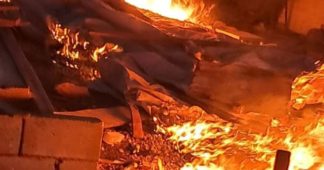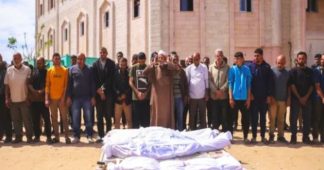Jul 18, 2025
Gaza City and tents sheltering displaced Palestinians in al-Mawasi, southern Gaza, have been hit by Israel.
At least 41 Palestinians have been killed since dawn across Gaza in Israeli attacks, medical sources have told Al Jazeera, as the besieged and bombarded enclave’s decimated health system, overwhelmed by a daily flow of wounded, is forcing doctors to make decisions on who to treat first.
In the latest killings on Friday, three people died in an Israeli attack on the Tuffah neighbourhood of eastern Gaza City. Five people were also killed in an Israeli air attack in Jabalia an-Nazla, in northern Gaza.
Earlier, an Israeli attack hit tents sheltering displaced Palestinians in al-Mawasi, southern Gaza – previously designated a so-called “safe zone” – igniting a major fire and killing at least five people, including infants. Al-Mawasi has come under repeated, deadly Israeli fire.
The death toll also includes includes 10 people who were desperately seeking aid.
Al Jazeera’s correspondent Hani Mahmoud said the injured, including children, were transferred to Nasser Hospital. Some showed wounds compatible with drone attacks.
“Drone missiles are packed with nails, metals and shrapnel that explodes at high speed, causing internal bleeding,” Mahmoud said. “These attacks are on the rise and target people in large crowds, in markets or while queueing for water.
‘What should we do? Die at home?’
Israel’s ongoing, punishing blockade of Gaza is forcing doctors in crammed medical facilities to make difficult decisions about who to treat.
Patients with chronic illnesses are often the first to miss out because emergency departments are overwhelmed by people wounded in Israeli attacks.
“Before the war, I used to receive dialysis three times a week, with each session lasting four hours. At that time, the situation was stable, the treatment was effective, and we would return home feeling well and rested,” Omda Dagmash, a dialysis patient, told Al Jazeera at the barely functioning al-Shifa Hospital in Gaza City.
“Now we can barely make the journey to the hospital, particularly since we are not eating well.”
At al-Shifa, the dialysis schedule has been scaled down to shorter and less frequent sessions. For some, it is a matter of life and death.
“The journey here is long and costly,” said Rowaida Minyawi, an elderly patient. “After all this exhaustion, we sometimes can’t find treatment. I have heart disease, high blood pressure and diabetes. Even the medicine we get is not good. What should we do? Die at home?”
Besides prioritising patients, healthcare workers say they have to scale back operations to the minimum, as no fuel means no power – and no way to save lives.
“Only a few departments are working. We had to cut electricity to the rest,” said Ziad Abu Humaidan, from the hospital’s engineering department.
“The hospital’s yards turned into graveyards rather than a place of care and healing. Without electricity, there is no lighting, no functioning medical equipment, and no support for other essential services.”
We remind our readers that publication of articles on our site does not mean that we agree with what is written. Our policy is to publish anything which we consider of interest, so as to assist our readers in forming their opinions. Sometimes we even publish articles with which we totally disagree, since we believe it is important for our readers to be informed on as wide a spectrum of views as possible.











